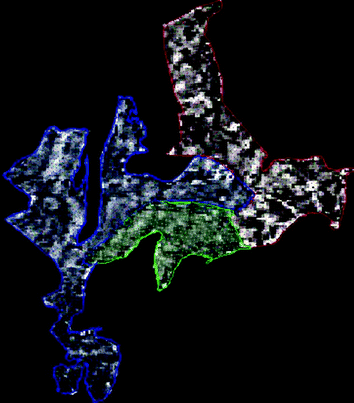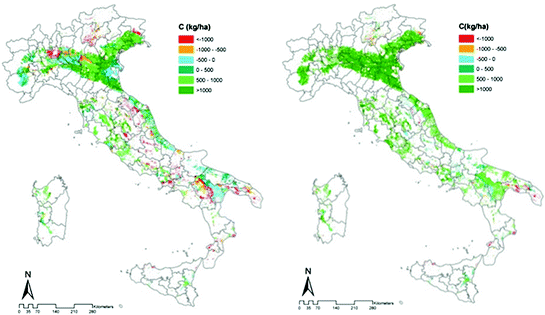Cropland and Grassland Management

Sequestration rate (t C ha−1)
BAU
RMP
Legnaro (PD)*
Cadriano (BO)**
Pisa (PI)***
Crop rotations
Monoculture
0.02 (±0.001)
Grass
Crop rotation
0.4 (±0.05)
Residue incorporation
Residue removal
0.10 (±0.07)
0.16
0.17
High inorganic rate
Low inorganic rate
0.038 (±0.016)
0.31–0.35d
0.20a (±0.07)
Animal Manure
Inorganic fertilizer
0.58b (±0.15)
0.26b
0.27c (±0.13)
0.18c
Conventional tillage
No tillage
0.67e
Main crops
Cover crops
0.08–0.34e
Beside these long-term trials, other shorter but very well monitored experimental fields are present in Italy, such as that carried on by the University of Udine at Beano (see Sect. 2.2.2). This site is equipped with two Eddy Covariance stations and a soils respiration system with several dynamic chambers, which also allow the measurement of N2O fluxes (Alberti et al. 2010). The fluxes campaign showed that conversion from maize to alfalfa was not effective in sequestering SOC with respect to continuous maize, in the short-term (2 years). However, data coming from a land use change chronosequence in that area (NE—Italy) (del Galdo et al. 2003), clearly highlighted that permanent grassland contained almost double SOC content than maize in the first 10 cm, and the same amount of C in the deeper layer (10–30 cm). In this study, afforestation of cultivated soils occurred 20 years ago resulted in significant sequestration of new C and stabilization of old C in physically protected soil organic matter fractions.
10.1.2 Modeling Application and Territorial Upscaling
Long and short-term field experiments allow the investigation of C and N turnover on a different temporal scale, but the results upscaling may be limited by the representativeness of the site pedo-climatic condition. In this context, biogeochemical process-based models could become very powerful tools, both to make prediction in time and space.
Up to present, with reference to modeling application in Italian agricultural fields only few works have been published. Lugato et al. (2006, 2007) extensively tested the SOC Century model using the long-term dataset of the University of Padova. The model was very accurate in simulating different agricultural managements involving a wide range of crop rotations and type of organic and mineral fertilizations. Furthermore, the authors made an analysis of the scenario (Lugato and Berti 2008), showing that recommended management practices could affect the C balance more strongly than climate change. Conversion to grassland was the most promising practice for sequestering C, allowing an average accumulation of 2.5 and 14 t C ha−1 at the end of the first Kyoto commitment period (2012) and in 2080, respectively.
The long-term dataset of the University of Bologna (Cadriano) was used by Plaza et al. (2012) to evaluate the performances of the process-based C model CQUESTR. The results indicated that the model was able to predict the SOC trend with a reasonable degree of accuracy, but further improvements may result from a better parameterization of the chemical composition and degradability of organic amendments.
Despite other model applications have been applied locally also in Mediterranean areas (as illustrates specifically in the next paragraph), territorial simulations at high spatial resolution are still lacking in Italy. As a deliverable of the project Carboitaly, Lugato et al. (2010) developed a platform of simulation to run DNDC for the entire national territory on a grid of 1 km2, linking the model with geographical databases. The main outcomes showed that N2O emissions were generally low (<0.5 kg N ha−1) with a simulated emission factor from fertilizers of 0.008, lower than the IPCC default of 0.0125 kg N2O–N kg−1 N. Cumulative emissions, covering 52 % of the arable land and 26 % of the woodland crops simulated, were 1.52 (±0.04) and −0.08 (±0.001) Mt of CO2 eq for N2O and CH4, respectively (negative values indicate CH4 oxidation).
This platform allowed the possibility to assess the net effects of alternative management practices applied spatially to different crops as, for example, the adoption of a minimum tillage on grain maize (Fig. 10.1). Under this scenario, the minimum tillage adoption allowed the accumulation of about 1.1 t ha−1 of SOC on average, saving more than 4 Mt of CO2 eq considering also the other GHG.


Fig. 10.1
Annual CO2 fluxes (kg C ha−1) in the grain maize with alternative management practices: conventional (left) versus reduced tillage (right)
Another attempt to investigate the effect of the change in land use on SOC stock at very high resolution was made by Coslovich (2011). He applied the GEF-SOC system (Easter et al. 2007), which links Century model with GIS data, to the administrative unit of Padova (NE Italy). Reconstructing the past land use since 1800, he was able to track the SOC evolution during the last century, making also a prediction of the future values according to two climatic scenarios (Had3A1FI and PCM-B1) (Fig. 10.2).


Fig. 10.2
SOC stock (t C ha−1) simulated for the year 2011 (a) and 1990 (b) in province of Padova, and SOC variation (2100–1990) for two climatic scenarios PCM-B1 (c) and Had3A1FI (d)
10.2 SOC Changes in Relation to Cropping Systems and Management in Mediterranean Semi-arid Areas
Understanding SOC changes in relation to ecosystem management is needed to develop C accounting models and future policies, oriented at attenuating the GHG warming effect. In arable lands, optimum levels of SOC could be mainly managed through crop rotations, tillage methods, inorganic fertilizers and organic manures (Kundu et al. 2007; Lal 2004). To mitigate the universally admitted deleterious effect of conventional cropping on SOC, several studies suggested to increase the frequency in the rotation of high biomass production and crops with elevated C/N ratio residue, as well as fertilize, apply organic manure, irrigate, and/or reduce tillage intensity (Su et al. 2006; Studdert and Echeverria 2000; Lal 2004; Sainju et al. 2006; Morari et al. 2006). However, the magnitude in SOC change following such usually recommended practices is soil and site specific. The potential of different eco-regions of the world to sequester C is in fact climatic dependent, being higher in tropical and temperate regions where crop growth conditions are more favourable.
The Italian territory encompasses a wide range of orographic and climatic conditions, ranging in latitude from about 47° to 36°N. In particular, most of the coastal areas of central and southern Italy, including the major islands, are affected by a typical Mediterranean climate. In this area, the interaction between land management and climate change is particularly critical due to frequently severe drought conditions and soils, which are inherently low in C and more susceptible to degradation.
The Island of Pianosa (see Sect. 2.2.18) is an interesting case study for SOC evolution related to land use change, as it was intensively cultivated for several centuries and completely abandoned since the end of 1990s. Vaccari et al. (2012) conducted a medium-term campaign of CO2 fluxes measurement with Eddy Covariance from 2002 to 2009, showing that the abandoned ecosystem was able to rapidly recover the SOC depleted during agricultural exploitation by about 30 % above the 1990s value. Furthermore, the authors calibrated the SOC-ecosystem model Century (Parton et al. 1988) with the measured data, in order to perform some scenario analysis. The results suggested that re-cultivation of these soils may potentially cause a SOC loss ranging from 41 to 58 t C ha−1 in the next 90 years, if appropriate soil conservation management practices are not implemented.